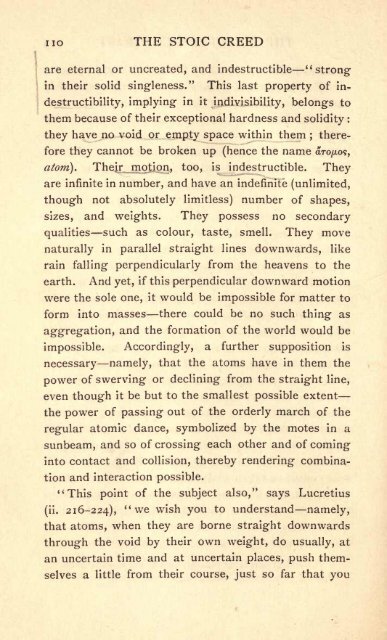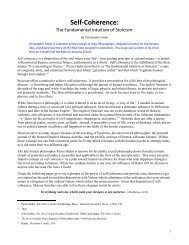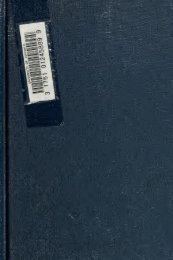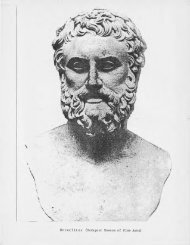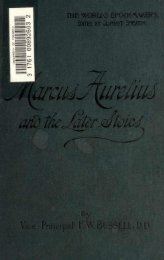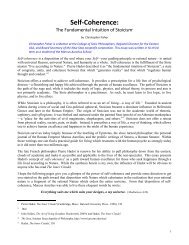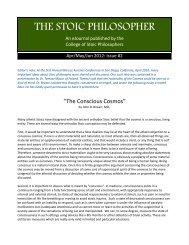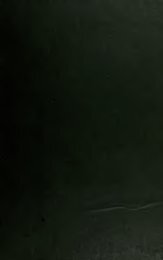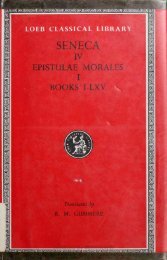- Page 5 and 6:
RELIGION IN LITERATURE AND LIFE THE
- Page 7 and 8:
RELIGION IN LITERATURE AND LIFE THE
- Page 9 and 10:
PREFACE THESE chapters are a contri
- Page 11 and 12:
TABLE OF CONTENTS MOULDING INFLUENC
- Page 13 and 14:
TABLE OF CONTENTS ix Farrar s Seeke
- Page 15 and 16:
" " " " "
- Page 17 and 18:
TABLE OF CONTENTS xiii CHAPTER VI T
- Page 19 and 20:
TABLE OF CONTENTS xv 111 Heracleitu
- Page 21 and 22:
" " " TABLE OF CONTE
- Page 23 and 24:
" " TABLE OF CONTENTS xix
- Page 25 and 26:
TABLE OF CONTENTS xxi THE DOCTRINE
- Page 27:
TABLE OF CONTENTS xxiii II PAGE Has
- Page 30 and 31:
2 THE STOIC CREED characteristics o
- Page 32 and 33:
" " 4 THE STOIC CREED the
- Page 34 and 35:
THE STOIC CREED is man s first , du
- Page 36 and 37:
8 THE STOIC CREED corrupting the yo
- Page 38 and 39:
io THE STOIC CREED in all essential
- Page 40 and 41:
12 THE STOIC CREED * c he will lear
- Page 42 and 43:
14 THE STOIC CREED dividual in char
- Page 44 and 45:
16 THE STOIC CREED they are ; etvai
- Page 46 and 47:
which " i8 THE STOIC CREED des
- Page 48 and 49:
CHAPTER II THE STOIC MASTERS AND TH
- Page 50 and 51:
" 22 THE STOIC CREED and which
- Page 52 and 53:
" Dear " 24 THE STOIC CRE
- Page 54 and 55:
" 26 THE STOIC CREED In the sa
- Page 56 and 57:
. To 28 THE STOIC CREED out all the
- Page 58 and 59:
" " 30 THE STOIC CREED un
- Page 60 and 61:
" 32 THE STOIC CREED of the sa
- Page 62 and 63:
" 34 THE STOIC CREED his wonte
- Page 64 and 65:
" To " He " SECTION
- Page 66 and 67:
" sophy ? From TT to " &q
- Page 68 and 69:
" 40 THE STOIC CREED human and
- Page 70 and 71:
" " 42 THE STOIC CREED th
- Page 72 and 73:
" 44 THE STOIC CREED doctrine
- Page 74 and 75:
" " " 46 THE STOIC C
- Page 76 and 77:
" 48 THE STOIC CREED they are
- Page 78 and 79:
50 THE STOIC CREED primary value (h
- Page 80 and 81:
52 THE STOIC CREED IV A further poi
- Page 82 and 83:
" " 54 THE STOIC CREED un
- Page 84 and 85:
" 56 THE STOIC CREED his first
- Page 86 and 87:
58 THE STOIC CREED were carried for
- Page 88 and 89: " 60 THE STOIC CREED His sons.
- Page 90 and 91: " CHAPTER IV LOGIC: THEORY OF
- Page 92 and 93: 64 THE STOIC CREED The later Stoics
- Page 94 and 95: 66 THE STOIC CREED iterated and emp
- Page 96 and 97: 68 THE STOIC CREED light shows both
- Page 98 and 99: " 70 THE STOIC CREED wrapped a
- Page 100 and 101: " " " 72 THE STOIC C
- Page 102 and 103: 74 THE STOIC CREED indispensable to
- Page 104 and 105: " 76 THE STOIC CREED looked up
- Page 106 and 107: " " " 78 THE STOIC C
- Page 108 and 109: " 8o THE STOIC CREED both spon
- Page 110 and 111: 82 THE STOIC CREED their own day. W
- Page 112 and 113: " Both " " CHAPTER V
- Page 114 and 115: 1 86 THE STOIC CREED 1 1 1 tending
- Page 116 and 117: " " " 88 THE STOIC C
- Page 118 and 119: " " " " "
- Page 120 and 121: " 92 THE STOIC CREED fire, 1 c
- Page 122 and 123: " 94 THE STOIC CREED unquestio
- Page 124 and 125: " 96 THE STOIC CREED First, wh
- Page 126 and 127: " " 98 THE STOIC CREED to
- Page 128 and 129: ioo THE STOIC CREED shut out from m
- Page 130 and 131: " " " " 102 THE
- Page 132 and 133: io 4 THE STOIC CREED of things. Hen
- Page 134 and 135: 106 THE STOIC CREED tion from other
- Page 136 and 137: " " io8 THE STOIC CREED h
- Page 140 and 141: " " ii2 THE STOIC CREED e
- Page 142 and 143: " ii 4 THE STOIC CREED in the
- Page 144 and 145: " " n6 THE STOIC CREED pa
- Page 146 and 147: " break " u8 THE STOIC CR
- Page 148 and 149: " A 120 THE STOIC CREED most c
- Page 150 and 151: 122 THE STOIC CREED excluding provi
- Page 152 and 153: " " 124 THE STOIC CREED T
- Page 154 and 155: " " " SECTION C. MOR
- Page 156 and 157: " " 128 THE STOIC CREED w
- Page 158 and 159: " 130 THE STOIC CREED an indiv
- Page 160 and 161: " 132 THE STOIC CREED in exter
- Page 162 and 163: 134 THE STOIC CREED and beauty of s
- Page 164 and 165: 136 THE STOIC CREED who could both
- Page 166 and 167: 138 THE STOIC CREED hence the attra
- Page 168 and 169: " " " CHAPTER VIII E
- Page 170 and 171: " " " 142 THE STOIC
- Page 172 and 173: " " i 44 THE STOIC CREED
- Page 174 and 175: " " " 146 THE STOIC
- Page 176 and 177: " 148 THE STOIC CREED judgment
- Page 178 and 179: " Ad ISO THE STOIC CREED grief
- Page 180 and 181: fy " " i 5 2 THE STOIC CR
- Page 182 and 183: " 154 THE STOIC CREED connexio
- Page 184 and 185: " " " 156 THE STOIC
- Page 186 and 187: " 158 THE STOIC CREED excels t
- Page 188 and 189:
" 160 THE STOIC CREED better n
- Page 190 and 191:
" " " 162 THE STOIC
- Page 192 and 193:
" Do " 164 THE STOIC CREE
- Page 194 and 195:
" There 166 THE STOIC CREED be
- Page 196 and 197:
" " 1 68 THE STOIC CREED
- Page 198 and 199:
" lyo THE STOIC CREED Moral Pr
- Page 200 and 201:
" " " 172 THE STOIC
- Page 202 and 203:
" " CHAPTER IX ETHICS: SP
- Page 204 and 205:
" " 176 THE STOIC CREED t
- Page 206 and 207:
" " Beloved 178 THE STOIC
- Page 208 and 209:
We " i8o THE STOIC CREED IV A
- Page 210 and 211:
" How " " i8 2 THE S
- Page 212 and 213:
184 THE STOIC CREED "all human
- Page 214 and 215:
" 186 THE STOIC CREED cheering
- Page 216 and 217:
" " Et " CHAPTER X E
- Page 218 and 219:
" (out 190 THE STOIC CREED pra
- Page 220 and 221:
" iQ2 THE STOIC CREED of these
- Page 222 and 223:
" " i 94 THE STOIC CREED
- Page 224 and 225:
196 THE STOIC CREED injuring himsel
- Page 226 and 227:
198 THE STOIC CREED But he is a bad
- Page 228 and 229:
" 200 THE STOIC CREED and stri
- Page 230 and 231:
" 202 THE STOIC CREED conversa
- Page 232 and 233:
" 204 THE STOIC CREED either s
- Page 234 and 235:
" " " 206 THE STOIC
- Page 236 and 237:
" We " " From "
- Page 238 and 239:
" " " 210 THE STOIC
- Page 240 and 241:
" 212 THE STOIC CREED Nature b
- Page 242 and 243:
" " " 214 THE STOIC
- Page 244 and 245:
" You " 216 THE STOIC CRE
- Page 246 and 247:
" " How " 2i8 THE ST
- Page 248 and 249:
220 THE STOIC CREED world as a univ
- Page 250 and 251:
" " " 222 THE STOIC
- Page 252 and 253:
" " " 224 TH^ STOIC
- Page 254 and 255:
226 THE STOIC CREED All this is nob
- Page 256 and 257:
" " Whatever " 228 T
- Page 258 and 259:
2 3 o THE STOIC CREED differs from
- Page 260 and 261:
" 232 THE STOIC CREED of prove
- Page 262 and 263:
" " 234 THE STOIC CREED t
- Page 264 and 265:
236 THE STOIC CREED whole, so that
- Page 266 and 267:
^ stitute 238 THE STOIC CREED momen
- Page 268 and 269:
" 2 4o THE STOIC CREED "
- Page 270 and 271:
242 THE STOIC CREED So that, thus f
- Page 272 and 273:
" " Watch 244 THE STOIC C
- Page 274 and 275:
" 246 THE STOIC CREED This als
- Page 276 and 277:
" " 248 THE STOIC CREED r
- Page 278 and 279:
s the " " There " &q
- Page 280 and 281:
" " 252 THE STOIC CREED T
- Page 282 and 283:
" 254 THE STOIC CREED who &quo
- Page 284 and 285:
" " " 256 APPENDIX c
- Page 286 and 287:
" God " 258 APPENDIX form
- Page 288 and 289:
" 26o APPENDIX reacting on imp
- Page 290 and 291:
" Pure " 262 APPENDIX Las
- Page 292 and 293:
" 264 APPENDIX ordinate it to
- Page 294 and 295:
266 APPENDIX Education aim at the i
- Page 296 and 297:
268 INDEX Comtists, their conceptio
- Page 298 and 299:
270 INDEX the doctrine Good, the, 1
- Page 300 and 301:
" 272 INDEX to Stoic Ethics, 1
- Page 302 and 303:
274 INDEX to happiness, 152 ; indiv
- Page 304 and 305:
" A A GREAT BIBLICAL ENCYCLOPE
- Page 306 and 307:
" " The World s Epoch-Mak
- Page 308:
The World s Epoch- Makers. DAVID HU


